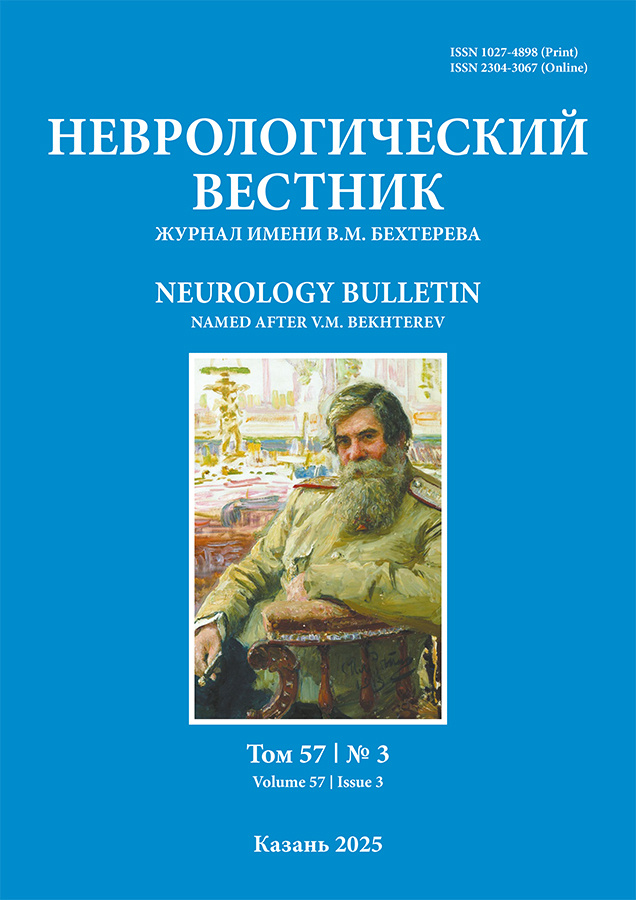Forensic psychiatric significance of socially dangerous acts against their children in women with schizophrenia
- Authors: Shport S.V.1, Khamitov R.R.2,3, Afzaletdinova D.K.4,5, Kachaeva M.A.1,6, Skibina N.V.1,6, Nazarova L.N.6
-
Affiliations:
- V.P. Serbsky National Medical Research Centre for Psychiatry and Narcology
- Kazan Special Psychiatric Hospital With Intensive Supervision
- Kazan State Medical University
- Bashkir State Medical University
- Republican Clinical Psychiatric Hospital, Ufa
- I.M. Sechenov First Moscow State Medical University
- Issue: Vol LVII, No 3 (2025)
- Pages: 237-246
- Section: Original study arcticles
- Submitted: 27.02.2025
- Accepted: 23.05.2025
- Published: 30.09.2025
- URL: https://journals.eco-vector.com/1027-4898/article/view/669182
- DOI: https://doi.org/10.17816/nb669182
- EDN: https://elibrary.ru/KOXEDQ
- ID: 669182
Cite item
Abstract
BACKGROUND: The study of risk factors for aggressive and violent acts against their children in women with schizophrenia remains relevant, as the relationship between psychopathological syndromes and socio-psychological factors is still insufficiently explored.
AIM: To identify psychopathological and social factors contributing to the commission of filicide by women with schizophrenia.
METHODS: Study design: this study is a multicenter descriptive retrospective comparative study of medical records and forensic psychiatric reports without the direct involvement of patients. Inclusion criteria for the main group: female sex, diagnosis of schizophrenia, committed child (children) murder in 2016–2023, and court decision on legal insanity of the patient. Study duration: from May to September 2024. Methods of evaluation: clinical-psychopathological, clinical-catamnestic, statistical.
RESULTS: The participants were divided into three groups: group 1 (main, n = 28), patients who committed filicide; group 2 (comparison, n = 34), patients who committed murder of a non-relative (acquaintance or stranger aged 18 years and older); and group 3 (control, n = 56), patients who did not commit any crimes. The results of the comparison between groups 1 and 2 are denoted as p1, between groups 1 and 3 as p2, and between groups 2 and 3 as p3. Comparative analysis showed that the incidence of filicide was statistically significantly higher at the debut of schizophrenia (р1 = 0.001); patients often did not see a psychiatrist before committing the crime (р1 = 0.026). The predominant mechanism of committing the crime was the productive-psychotic mechanism (p1 = 0.001), with identified features of delusions combined with an altruistic motive. Among the personality traits, a tendency toward defensiveness, touchiness, and impressionability predominated (p1 = 0.001).
CONCLUSION: The analysis showed a predominance of psychopathological syndromes in cases involving filicide and a greater significance of social factors in cases involving aggressive and violent acts against non-relatives. The revealed predictors can help prevent socially dangerous behavior in women with schizophrenia.
Full Text
About the authors
Svetlana V. Shport
V.P. Serbsky National Medical Research Centre for Psychiatry and Narcology
Email: svshport@mail.ru
ORCID iD: 0000-0003-0739-4121
SPIN-code: 2926-9305
MD, Dr. Sci. (Medicine)
Russian Federation, MoscowRustem R. Khamitov
Kazan Special Psychiatric Hospital With Intensive Supervision; Kazan State Medical University
Email: rrkzn@mail.ru
ORCID iD: 0000-0002-1271-8330
SPIN-code: 4923-9370
MD, Dr. Sci. (Medicine), Professor
Russian Federation, Kazan; KazanDinara Kh. Afzaletdinova
Bashkir State Medical University; Republican Clinical Psychiatric Hospital, Ufa
Author for correspondence.
Email: dinara-05@list.ru
ORCID iD: 0000-0003-1042-3528
SPIN-code: 4090-3272
MD, Cand. Sci. (Medicine)
Russian Federation, Ufa; UfaMargarita A. Kachaeva
V.P. Serbsky National Medical Research Centre for Psychiatry and Narcology; I.M. Sechenov First Moscow State Medical University
Email: mkachaeva@mail.ru
ORCID iD: 0000-0002-7642-9829
SPIN-code: 4565-1293
MD, Dr. Sci. (Medicine), Professor
Russian Federation, Moscow; MoscowNadezhda V. Skibina
V.P. Serbsky National Medical Research Centre for Psychiatry and Narcology; I.M. Sechenov First Moscow State Medical University
Email: nskibina59@mail.ru
ORCID iD: 0000-0003-4721-3962
SPIN-code: 6215-1636
MD, Cand. Sci. (Medicine), Assistant Professor
Russian Federation, Moscow; MoscowLionella N. Nazarova
I.M. Sechenov First Moscow State Medical University
Email: LnLn2016@bk.ru
ORCID iD: 0000-0003-1991-0920
SPIN-code: 5926-0863
MD, Cand. Sci. (Medicine), Assistant Professor
Russian Federation, MoscowReferences
- Klier CM, Fisher J, Chandra PS, Spinelli M. Filicide research in the twenty-first century. Arch Womens Ment Health. 2019;22(1):135–137. doi: 10.1007/s00737-018-0924-0
- Mugavin M. Maternal filicide theoretical framework. J Forensic Nurs. 2008;4(2):68–79. doi: 10.1111/j.1939-3938.2008.00012.x
- Dmitrieva TB, Immerman KL, Kachaeva MA, Romasenko LV. Criminal aggression of women with mental disorders. Moscow: Medicina; 2003. 246 р. (In Russ.) ISBN: 5-225-04311-9
- Kachaeva MA, Kharitonova NK, Vasyanina VI, et al. Mental disorders in women victims of domestic violence. A case of child murder (extended suicide). In: Fastovtsov GA, editor. The practice of forensic psychiatric examination: Collection No. 61. Moscow: NMICzPN im. V.P. Serbskogo; 2023. Р. 100–108. (In Russ.) EDN: CYEGLB
- McCarroll JE, Fisher JE, Cozza SJ, et al. Characteristics, classification, and prevention of child maltreatment fatalities. Mil Med. 2017;182(1):e1551–e1557. doi: 10.7205/MILMED-D-16-00039
- Lattanzi GM, Provini L, Williams R, et al. Personality structure and attachment models of women who kill their children. A systematic review on maternal filicide. Child Abuse Negl. 2020;106:104532. doi: 10.1016/j.chiabu.2020.104532
- Friedman SH, Horwitz SM, Resnick PJ. Child murder by mothers: a critical analysis of the current state of knowledge and a research agenda. Am J Psychiatry. 2005;162(9):1578–1587. doi: 10.1176/appi.ajp.162.9.1578
- Putkonen H, Amon S, Weizmann-Henelius G, et al. Classifying Filicide. International Journal of Forensic Mental Health. 2016;15(2):1–13. doi: 10.1080/14999013.2016.1152616
- Brown T, Bricknell S, Bryant W, et al. Filicide offenders. Trends and Issues in Crime and Criminal Justice. 2019;(568):1–17.
- Ospanova AV, Kachaeva MA, Kharitonova NK, et al. The case of child abuse by a woman with schizophrenia. Delegated Munchausen proxy syndrome. In: Fastovtsov GA, editor. The practice of forensic psychiatric examination: Collection No. 58. Moscow: NMICzPN im. V.P. Serbskogo; 2020. Р. 28–40. (In Russ.) EDN: XVFNME
Supplementary files






